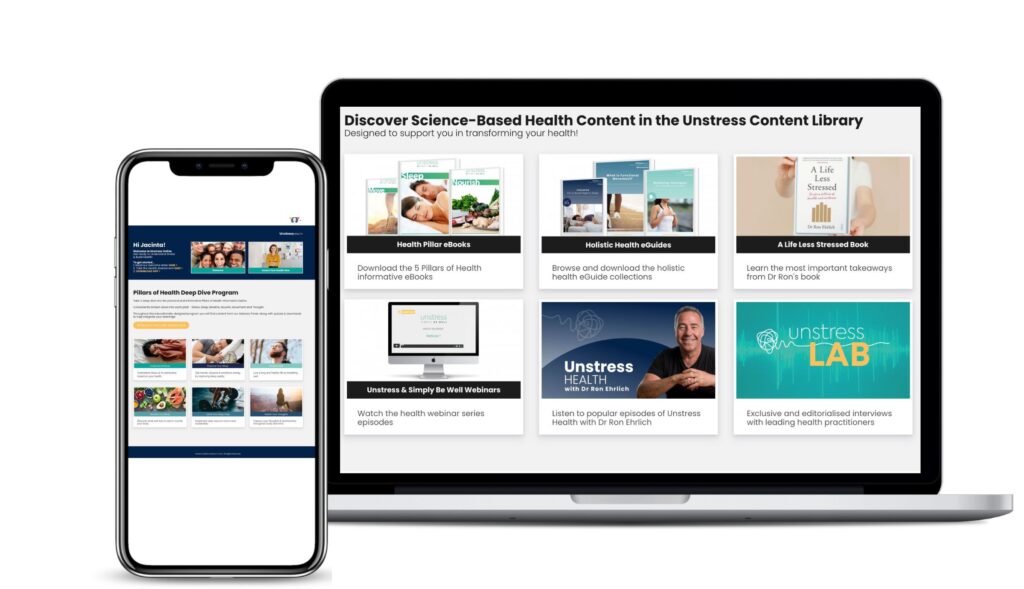What is the meaning of life? It’s most likely safe to assume you have asked yourself this big and important question throughout some stage of your life, or you will at some point in the future.
Unstress Health’s CEO & Founder, Dr Ron Ehrlich offers one possible and insightful answer to this complex question… to fulfil your potential!
Fulfilling your potential offers a broad spectrum of possibilities and is completely subjective. Focus and goals differ for everyone. Perhaps you have at the top of your list finances and career development, others may have a social circle, family or recreational activities, it may even be in the area of spiritual development, it is where you prioritise and desire, to be the best you can be.
Whilst success differs from person to person, there is one factor that determines how likely you are to fulfil your potential… good health.
There is no contention; the healthier you are, the more opportunities you have to thrive and be the best possible version of yourself.
Whether this is being part of a community, a relationship, a family, or amongst friends – being in good health and preventing illness and disease is absolutely central.
How is good health achieved?
In the Western world, we are privileged to have access to life-saving healthcare in times of crisis. If you have been fortunate to not need the skill, knowledge, expertise and knowledge of the Western healthcare system personally, then a family member or friend would have benefited from this.
When it comes to chronic disease, the Western healthcare system has become more of a chronic disease management system with each disease requiring medication and multiple diseases requiring multiple medications.
This type of management or treatment offers an isolated view of health. This model discounts the interconnectedness of the body itself, as well as our relationship with each other, the environment and the planet.
To consider all of these factors together is to take a holistic view of health, a view now being adopted by a growing number of practitioners and clinicians and the community.
The current chronic disease management model is a great economic model. Supported by the chemical and food industry and then managed by the pharmaceutical industry – an industry with a revenue stream of around $1.2 trillion a year.
This is observed through pharmaceutical companies ensuring shareholder return by influencing public health policy which can often be missed even by the well-meaning health practitioner. Of course, there are many wonderful things that have been born from the pharmaceutical world, however, it is not constructive to rely on this method to address the cause of chronic disease and truly shift the focus to prevention.
In order to achieve health, we need to build individual resilience to future-proof ourselves for all health challenges. By building individual health, we will achieve collective health.
Preventative health – how are we doing?
Preventable chronic degenerative diseases are devastating and at epidemic proportions. Whilst we are all living longer, we are living with more disease. These conditions, also known as non-communicable diseases (NDSc), have enormous health consequences for individuals, families and communities, and are overwhelming health systems.
When we assess the health conditions such as heart disease, cancer and diabetes, we can see that many illnesses impacting the community are preventable chronic degenerative diseases.
NCDs kill 41 million people each year, equivalent to 74% of all deaths globally.1 The top NCD killers are
- Heart disease (or Cardiovascular diseases) still remains the number one killer worldwide. Around 18 million people a year die of heart disease. That’s around 50,000 people a day and represents 32% of all global deaths1
- Cancer is the second leading cause of death. Around 10 million people a year die globally, which is around 27,000 people a day.1
- Chronic respiratory diseases are third, accounting for around 4.1 million deaths globally.1
- Diabetes is number four. 85% of diabetes sufferers are type two diabetics.
In the past it was referred to as late-onset diabetes, now it is seen to affect children as young as four years old and is now referred to as type 2 diabetes.1
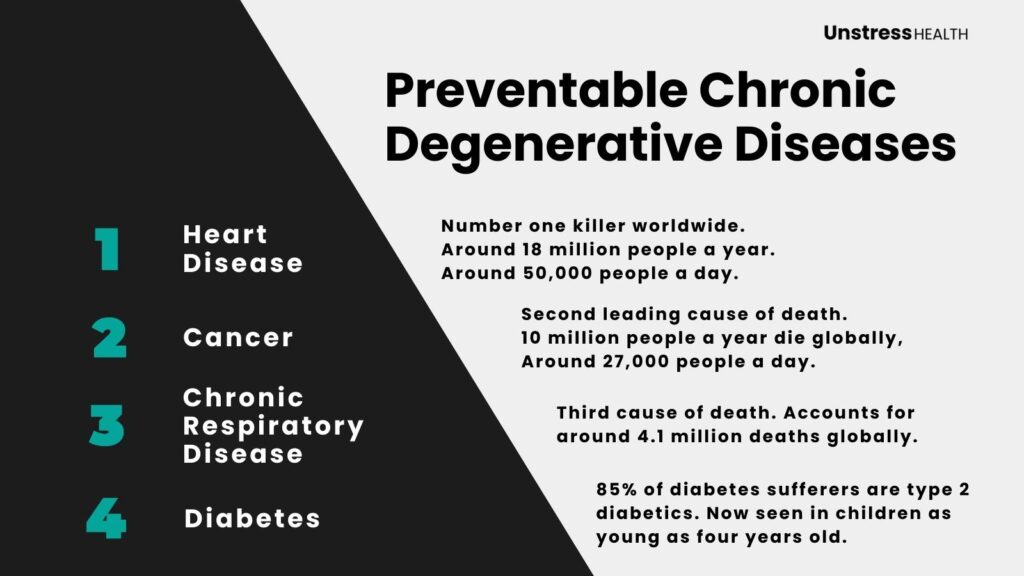
These four groups of diseases account for over 80% of all premature NCD deaths.1
Autoimmune conditions also have a huge impact globally. There are more than 80 known autoimmune diseases. Some are well-known, such as type 1 diabetes, multiple sclerosis, lupus, and rheumatoid arthritis, while others are rare and difficult to diagnose. With unusual autoimmune diseases, patients may suffer years before getting a proper diagnosis
An autoimmune condition is a body attacking itself and your genes determine how this will manifest. For example
- Gut: Genetically, if your weak link is the gut, then the body attacking itself may be expressed as irritable bowel syndrome, ulcerative colitis, Crohn’s disease or coeliac disease.
- Nervous System: If your weak link is with the nervous system, you may have a neurological condition such as Parkinson’s, multiple sclerosis, dementia or Alzheimer’s disease.
- Pancreas: If your weak link is your pancreas, it may be expressed as type 1 diabetes.
- Joints: If your weak link is your joints, you may have rheumatoid arthritis.
- Skin: If your weak link is your skin, you may have psoriasis or any one of a number of other skin conditions.
What is impacting our individual & collective ability to prevent chronic illness?
Dr Ron notes, as he has shared in his book ‘A Life Less Stressed’, when it comes to public health messages and in particular nutritional guidelines, he feels it helps to understand how the guidelines are formulated in the first place.
In his own experience and understanding, for the last 30 to 40 years, public health messages have been at the beck and call of industry, and industries’ main priority is to make a good return for shareholders, with public health not always their main priority.
An example of the conflicts of interest at play and the influence of industry on public health messages is dietary guidelines.
Dietary Guidelines – who really wins?
Part of the public health messages in nutrition came about when the Dietary Guidelines in America were formulated in the late 1970s and then morphed into a food pyramid around 1980.
Once the food pyramid and public health policy were adopted, obesity went through the roof. Yes, correlation doesn’t necessarily mean causation, however, the connection between the nutritional guidelines and rising obesity levels cannot be dismissed.
In addition to the increase in obesity, diabetes has also skyrocketed, type 2 diabetes in particular. Since the food pyramid was implemented, in both the United States and Australia, the rise has continued to increase every year.
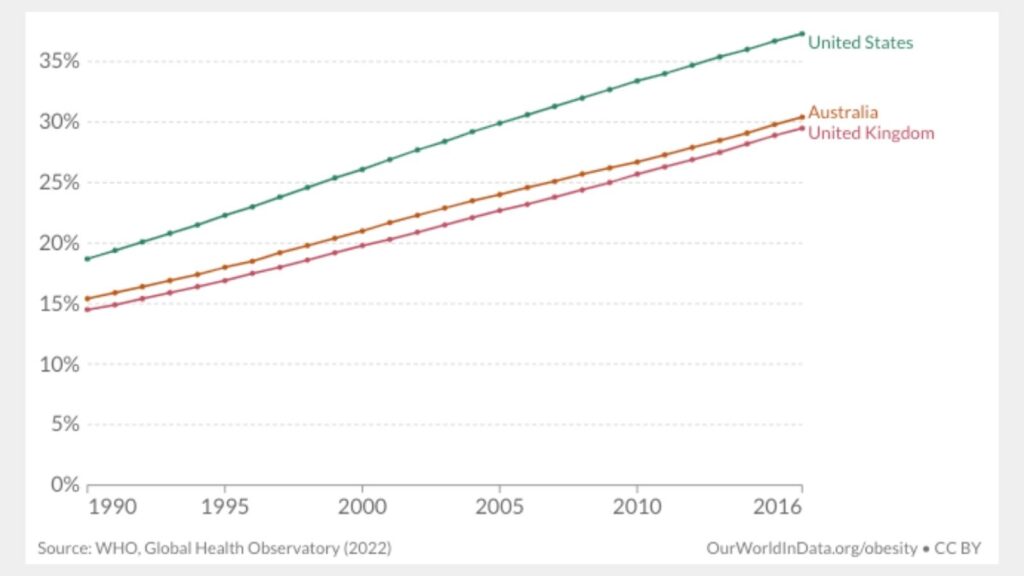
When we look at global nutritional problems, we are confronted with images of both processed food and fast food. Yes they are most certainly a contributing factor, yet it can be argued, this is not the main nutritional stress which poses problems we see today.
Dr Ron would argue it is the food pyramid that was endorsed by the Food and Drug Administration (FDA) in America in 1992. At its base are bread, cereals, rice, and pasta, with a recommendation of 6 to 11 servings per day.
In addition, it advises avoiding fats. Low fat was equated with health, however, perhaps all it did was make you hungry and encouraged more food.
This would be an ideal result for both the food and pharmaceutical industry… if people were hungry, they would eat more of what they were told to eat, increasing consumption of those foods. If those foods led to weight gain, obesity and eventually diabetes, there would be a greater need for medication.
Good for industry… not so good for the individual.
In 2011, the pyramid morphed into the My Plate, another U.S. government-endorsed public health message. Essentially the same as the food pyramid and in Australia this became the Australian Dietary Guidelines – A Guide to Healthy Eating in 2011 (aka Healthy Eating Guidelines)
The government advice was easily adopted and accepted by busy health practitioners, working on the frontline to treat the rise of chronic illness.
Dietary guidelines have changed very little over the last 30 years, the message is still to include carbohydrates in every meal and limit fat as much as possible. Which possibly already sets individuals up for failure when it comes to preventing future chronic illness.
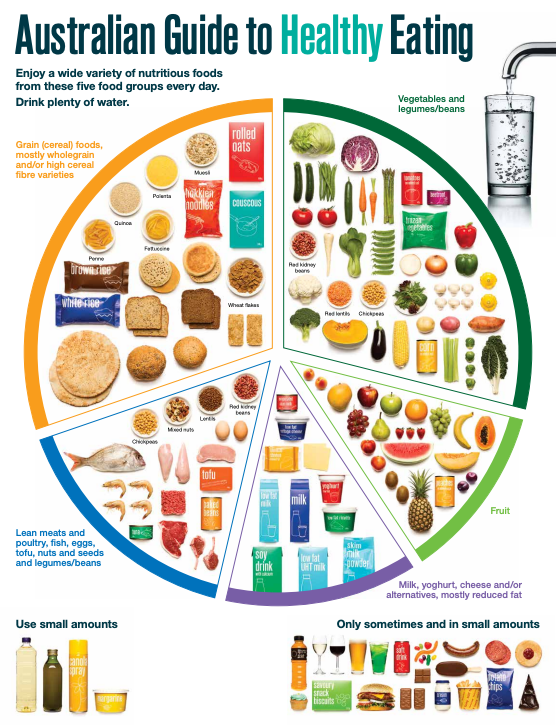
Dietary Guidelines – how are they formulated?
When we take a step back and take a look at how the guidelines and advice are formulated, they are distributed by leading associations and advised by large organisations.
The conflict of interest is found within the corporate sponsorship of such organisations. Long lists of sponsors, from many well-known processed food and beverage companies and pharmaceutical companies, can be found on the websites of the organisations creating the recommendations.
This provides insight into where the advice may lead as well as the obvious conflicts of interest, particularly if the primary interest of a company, according to their agreements, is to provide the best return for shareholders.
Dr Ron also shares an example of how corporate influence affects public health policy:
In 2003, the American Academy of Paediatric Dentistry said. “Frequent consumption of sugar in any beverage can be a significant factor in the child or adolescent diet that contributes to the initiation and progression of dental caries.” In other words, sugar in drinks causes tooth decay. Not very controversial, anybody with even the most cursory interest in nutrition could agree.
Then in 2004, Pepsi Cola donated $1,000,000 to the American Academy of Paediatric Dentistry. The same year, their public health message was changed to:
“Scientific evidence is certainly not clear on the exact role that soft drinks play in terms of children’s oral disease.”
Read further about how food & pharmaceutical industries can influence healthy eating guidelines. We dive much deeper into this in the Unstress Nourish Module and throughout the content on the Unstress Membership.
Children’s Health – an insight into future collective health
It’s important to stop and look at the health of our children, for children are the canaries in the coal mine – giving insight into future challenges in health.
In Australia;
- Asthma – In 2017–18, an estimated 10% (around 460,000) of Australian children aged 0–14 were reported to have asthma as a long-term condition.2
- Mental health conditions – In 2013–14, an estimated 314,000 children aged 4–11 (almost 14%) experienced a mental disorder.3
- Attention deficit hyperactivity disorder (ADHD) – ADHD was the most common disorder for children (8.2%).3
- Oral health – In 2012-14, around 2 in 5 (42%) children had experienced decay in their primary (baby) teeth, and 1 in 4 (24%) children had experienced decay in their permanent (adult) teeth.4
- Overweight and obesity – 25% of children aged 5-17 years were overweight or obese.5
- Physical Activity – In 2011–12, less than one-quarter (23%) of children aged 5–14 undertook the recommended 60 minutes of physical activity every day.6
Why should we be concerned?
Good health influences how children feel and go about their everyday lives because health can affect participation in family life and schooling, in addition to social and sporting activities.
What could this look like in the future or 10 years from now, for both individuals and on a larger scale?
- Higher incidences of already increasing chronic health conditions
- Increased average body weight
- Less mobility as we age
- Larger burden on health care system
- Large medical bills for individuals
- Lower quality of life as we age
Your future, and the collective future, doesn’t need to look like this…by focusing on the right areas, we can reduce current and future health burden
How to be healthy, prevent chronic illness and fulfil your potential
When we look at the increase in chronic health conditions, our current health system and public health messaging have the potential to cause further confusion.
Stress is ubiquitous. We are all affected by modern stress, and it is not necessarily affecting us in a positive way.
This is why Dr Ron’s book is A Life Less Stressed, not a Life Without Stress because this just isn’t possible in our modern and complex world.
To be healthy, prevent chronic illness and fulfil our potential we need to identify & minimise stress, build resilience and realise we are not a victim of our genes.
How do we define stress?
Stress is anything with the potential to compromise your immune system and anything that may promote chronic inflammation.
You need a strong immune system to deal with health threats, thus a strong immune system is number one.
Chronic inflammation is the common denominator in all diseases, physical and mental.
How do we identify & minimise stress – address the 5 stressors
We can manage stress and its potential effects on the body, by identifying and minimising the 5 stressors – emotional, nutritional, environmental, postural and dental stress.
They’re all equally important and influence each other:
Emotional Stress: It is affected by many other aspects of our health. And while we may not be able to change the things happening around us or the people affecting us, it is possible to change our attitude towards such things. Emotional stress is only one aspect of stress.
Nutritional Stress: Whenever you hear problems around the food we consume, it’s common to be shown fast food and processed food. Unstress would argue the food pyramid, literally pushed down our throats since the late 80s and mid-early 90s is the biggest nutritional stress facing society. Learning unbiased, basic eating principles is key to managing nutritional stress.
Environmental stress: We are literally exposed to tens of thousands, if not one hundred thousand chemicals, with an assumption of its safety and it has been tested if it’s on the supermarket shelf or in our food. The sad fact is, this is not the case. If you make informed decisions, you can reduce your environmental toxic load by up to 80 or 90 per cent.
Postural Stress: We sit, we look at computers, and we look down at our phones. It is challenging enough carrying the ten-pound/four-and-a-half-kilo head on our shoulders without changing the dynamics and looking down or leaning forward. As we look at our computers, we spend so much time sitting. even in postural stress. How we sleep and how we sit on the toilet, can also potentially cause postural stress.
Dental Stress: This is the stressor which often surprises people. And so I include dental stress in this for two reasons. The connection between the mouth and stress is through chronic infections and inflammation, very few of which cause pain. There is the biocompatibility of the materials going into our mouths, the shape and size of the mouth, literally determining the size and shape of the upper airway, making you more predisposed to disordered breathing and most importantly, sleep-disordered breathing, which is a huge health issue.
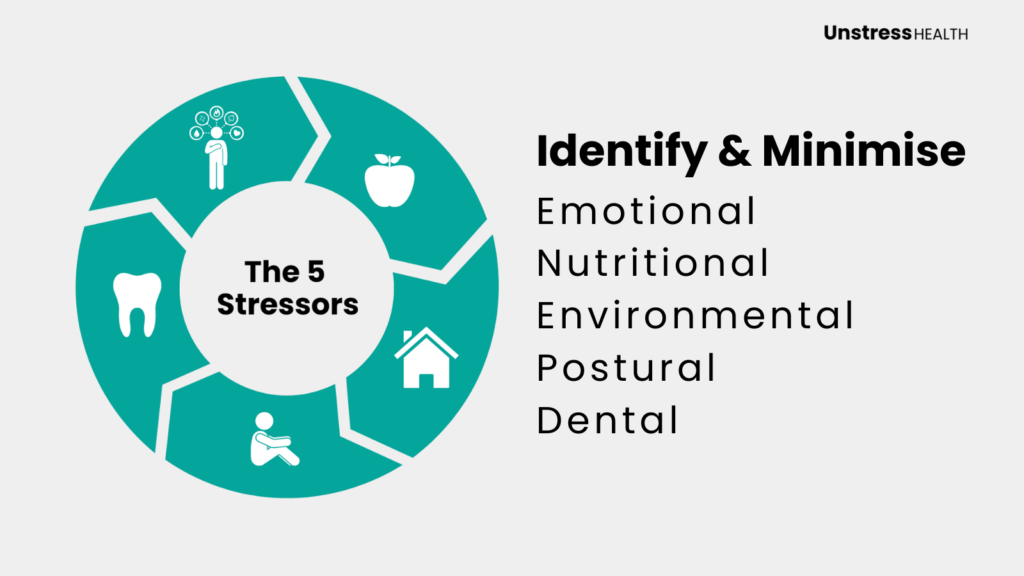
How do we build resilience – focus on the 5 Pillars of Health
Once you can identify and minimise stress, the other side of the equation is to build resilience. In order to build resilience there is a focus on the 5 Pillars of Health; sleep, breathe, nourish, movement and thought.
Optimise Sleep: Sleep is foundational. It is the main building block of health and as such, the most important part of the day. We provide simple yet impactful sleep strategies to increase your mental, physical and emotional energy to improve your quality of life. By improving your sleep, you will make the most profound changes to your health. You may also:
- Provide the body and mind with the ability to fulfil everyday activities
- Boost overall improved mood
- Increase brain health and reduce risk of chronic health
- Balance body weight
Breathe Well: Understanding the importance and learning the skill of breathing well is a key aspect to improving your overall health. Learning good breathing habits and improving breathing efficiency and function is critical to so many aspects of health; body chemistry, posture, muscle function, stress and a wide range of health conditions. By learning to breathe well, you will improve your body chemistry and the way it functions. You may also:
- Enjoy a better quality of sleep
- Improve the body’s immune response and viral fighting capabilities
Nourish Your Body: What you put in and on your body impacts your wellbeing. Learning how to make food choices provides clarity on what and how to eat to nourish the body well. There are confusing and conflicting health messages out there, so understanding the basics is required and allows for achievable and sustainable food choices. By learning how to nourish your body well, you will gain confidence regarding food choices. You may also:
- Reduce inflammation
- Decrease risk of chronic health conditions
- Reverse nutrient deficiencies
Move Daily: Physical activity was once a routine part of most people’s lives. The decline of physical activity in modern society has influenced health outcomes. Implement sustainable and easy ways to move daily to increase mobility and strength. By learning how to move daily, you will increase strength and mobility to ensure a stronger body throughout all of life. You may also:
- Improve sleep quality
- Balance body weight
- Increase energy
Watch Your Thoughts: Mental health issues are an increasing problem for our collective wellbeing. People are stressed, anxious and depressed. Improve your thoughts and biochemistry throughout the body and mind with practical exercises. By learning how to improve the quality of thought, you will improve your overall wellbeing. You may also:
- Lower stress and anxiety levels
- Reframe negative thought patterns to more positive thought patterns
- Find more joy
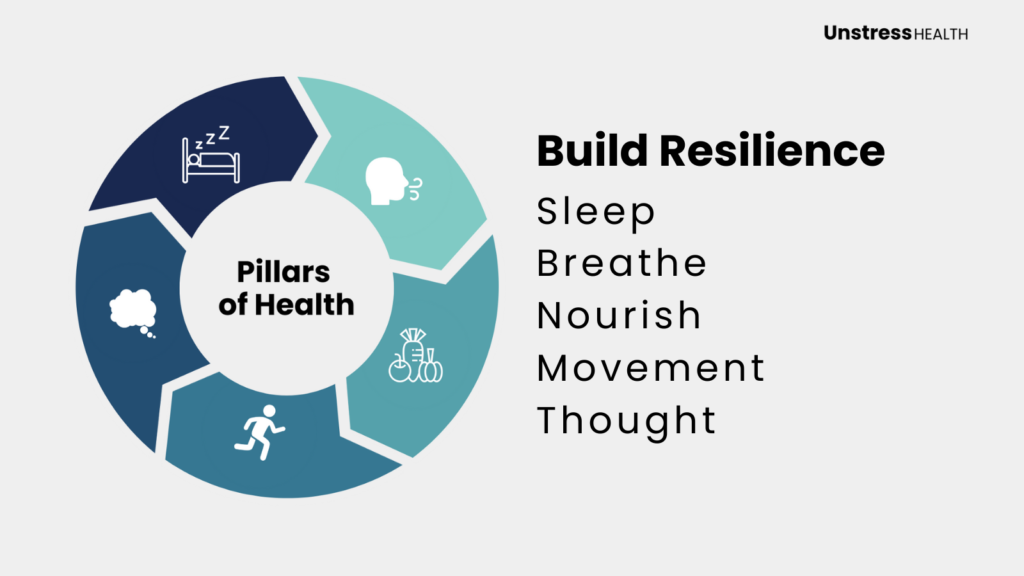
Are you a victim to your genes?
We should have respect for our genes, family history does count.
However, you are not a victim of your genes.
The 5 stressors and the 5 Pillars of Health all have the ability to cause your genes to express themselves in either a positive or negative way, this is called Epigenetics – a wonderful and empowering new science.
There is how your genes express themselves, which is the wonderful new science and empowering science of epigenetics.
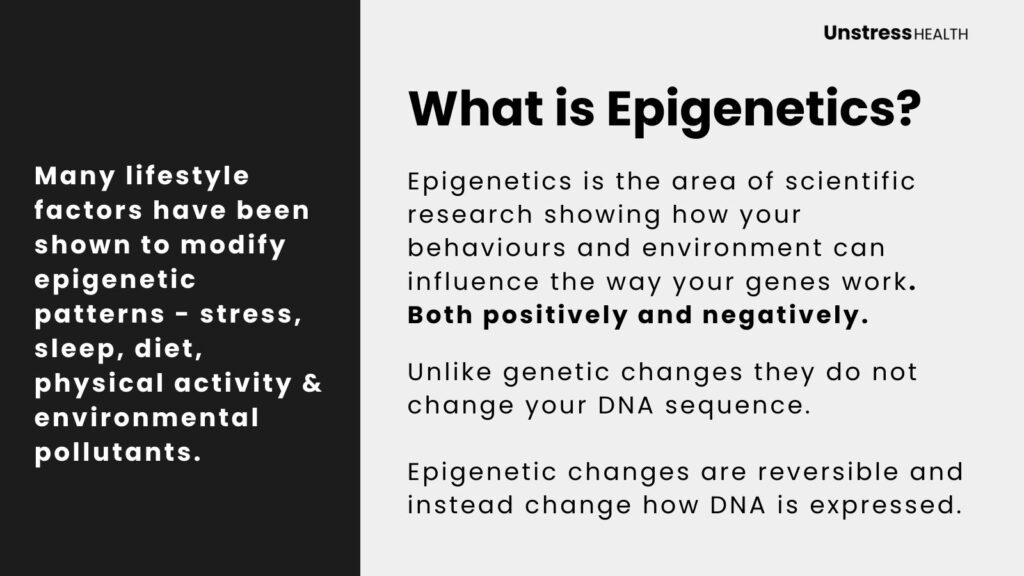
The 5 stressors, the 5 pillars of health and your genes – a holistic model
So how do we build individual health to transform collective health? How do you fulfil your potential?
The answer is to view health in a holistic way, putting everything together.
The Unstress Holistic Health model redefines what stress means – stress is anything that compromises immune function and promotes chronic inflammation – the two common denominators in every disease. Therefore identifying and minimising stress sits on one side of the balance beam.
Once you’ve explored stress, the other side of the balance beam is to build resilience through the 5 pillars of health.
The whole balancing beam pivots on your genes. But you are not a victim of your genes. Epigenetics is important – i.e. how your genes express themselves through the stress you are exposed to and resilience based on healthy choices.
You are the one that can take control of your health.
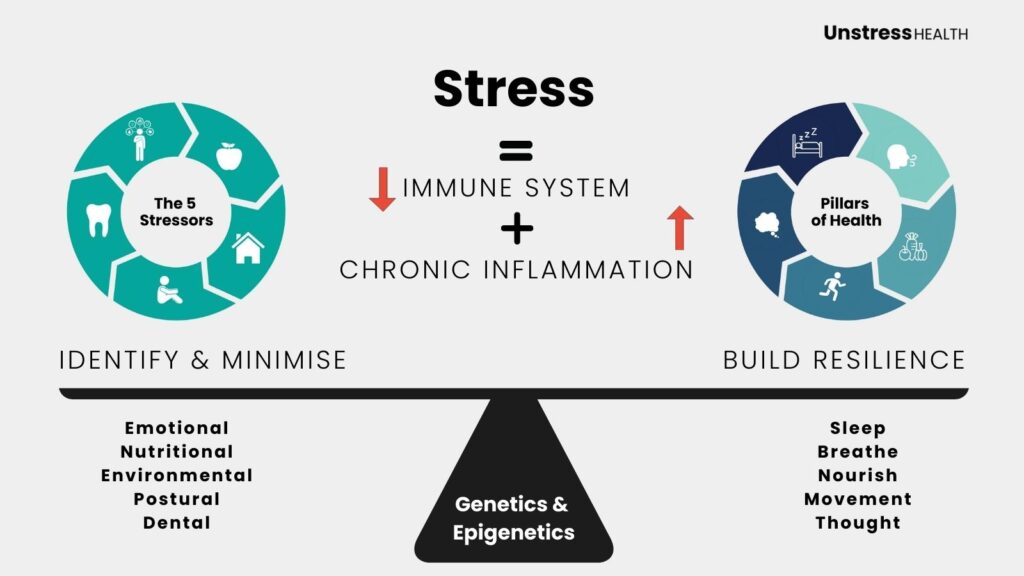
Take control of your health and fulfil your potential!
Unstress Health is built on clinical experience, offering health solutions created in collaboration with some of the greatest minds and clinicians in health and backed by a professional and passionate advisory panel.
Meet the advisory panel

We offer you a journey of self-empowerment, which will transform your life and quite literally may save your life.
Unstress Health with Dr Ron Podcast
The Unstress Health with Dr Ron Ehrlich podcast has been running since 2019 and already produced almost 300 episodes and interviews with health experts.
Dr Ron has the privilege of connecting with health guests ranging from researchers, professors, doctors, practitioners and clinicians who all carry a wealth of knowledge on various health subjects and answering many burning questions.
Listen to featured episodes of the Unstress Health Podcast, or take a look at the complete list of episodes.
Unstress Health Membership & Programs
The Unstress Health Membership provides exclusive access to simple, practical and results driven solutions for understanding stress and improving health.
With a subscription you receive access to the:
- Unstress Digital Library – offering ondemand health webinars, premium podcast, informative eBooks and the complete collection of holistic health eGuides.
- Unstress Health Programs – master your sleep with the 5 Days to Better Sleep program and learn to identify and minimise the five stressors with the 5 Days to Manage Stress program. The Unstress programs are constantly evolving.
- Interact with Experts & Clinicians – a direct line to health information and practical advice and the opportunity to engage with leading-edge experts in the quarterly LIVE Q&A sessions for the community.
- Feel Connected & Supported – the Unstress private Facebook group provides a safe and supported space to feel connected with others… ask, share, engage and thrive!
The Unstress Health Mission & Values
Supporting individual health and transforming collective health
Unstress Health’s mission is to build individual health and unlock individual potential by delivering health solutions in collaboration with some of the greatest minds and clinicians in health. We believe by supporting individual health and potential, we can impact and transform collective health.
In support of achieving our mission, Unstress Health will always aim for our solutions to be delivered in alignment with our values:
Accessible & Affordable
We ensure our health solutions are accessible to everyone. We do this by offering our programs 100% online via our easy and educational digital platform. And offer a free resources hub, supplying a wealth of health information from leading-edge doctors, researchers, professors and clinicians. We ensure our health solutions are affordable to everyone. We price our programs fairly and monitor pricing regularly to make certain there is no gap or privilege in accessibility to health information and education.
Achievable & Sustainable
Holistic & Science-Based
Simply, holistic means – the way the body works. It’s a bird’s eye view of the entire system, the whole body, taking into consideration how everything interacts. Our approach is always holistic, as we believe this is the only way true health can be achieved. We share this view with all members of the Unstress Advisory Panel – and our contributors – doctors, researchers, professors and clinicians, all of whom practice science-based medicine.


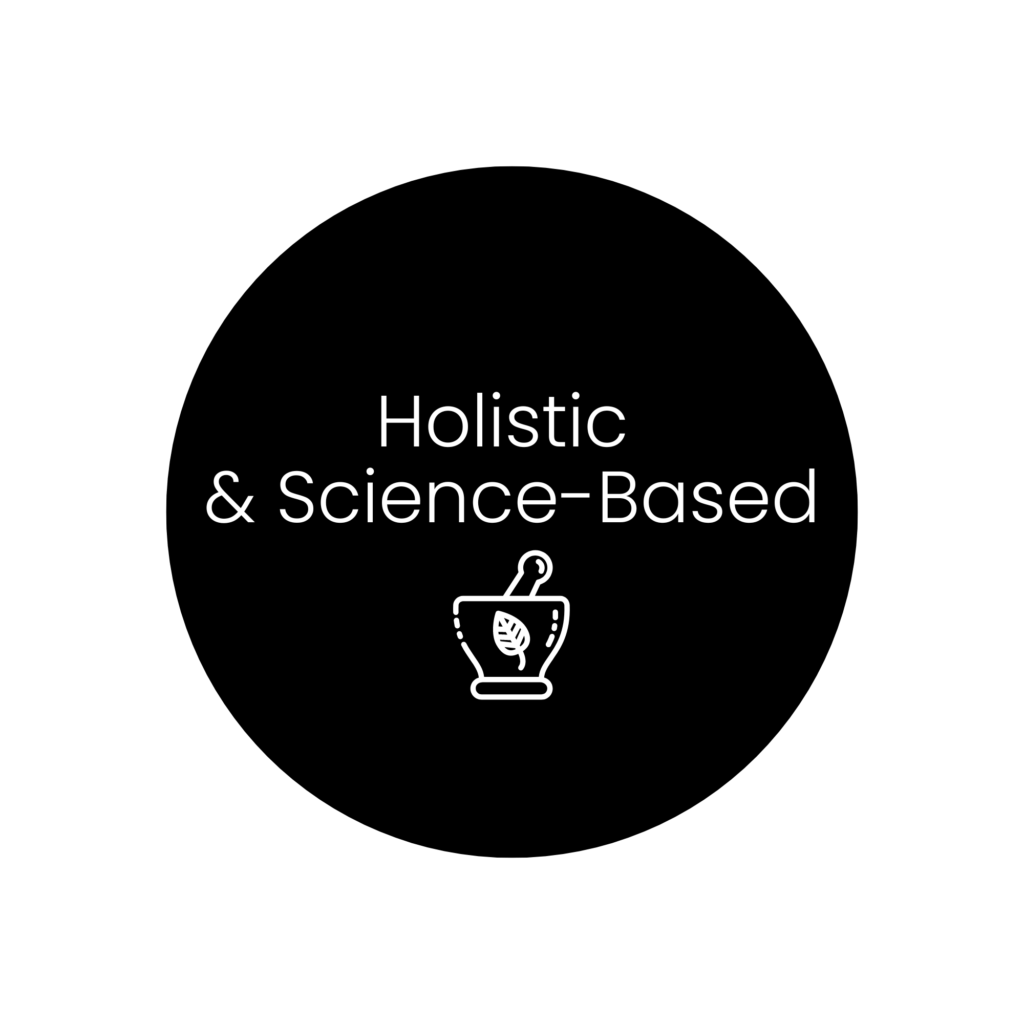
References:
- Global, regional, and national age-sex-specific mortality for 282 causes of death in 195 countries and territories, 1980–2017: a systematic analysis for the Global Burden of Disease Study 2017. Global Health Metrics | Volume 392, Issue 10159, P1736-1788, November 10, 2018 accessed here
- Alternative source for noncommunicable disease information
- Australian Bureau of Statistics (2017-18), National Health Survey: First results, ABS Website, accessed 19 October 2022.
- Goodsell, B. T., Lawrence, D. M., Ainley, J., Sawyer, M., Zubrick, S. R., & Maratos, J. (2017). Child and Adolescent Mental Health and Educational Outcomes: An analysis of educational outcomes from Young Minds Matter: the second Australian Child and Adolescent Survey of Mental Health and Wellbeing. The University of Western Australia. Accessed here
- Armfeld JM, Chrisopoulos S, Peres KG, Roberts-Thomson KF & Spencer AJ 2016. Australian children’s oral health behaviours. In: Do LG & Spencer AJ (eds). Oral health of Australian children: the National Child Oral Health Study 2012–14. Adelaide: University of Adelaide Press.
- Australian Bureau of Statistics (2017-18), Children’s risk factors, ABS Website, accessed 19 October 2022.
- Australian Bureau of Statistics (December 2011), Australian Health Survey: Nutrition First Results – Foods and Nutrients, ABS Website, accessed 19 October 2022.


